

5 Such legal drivers will push governmental bodies as well as industry to address plastic recycling, ideally in a manner which is circular and enables value creation. Regarding current legislative encouragement for recycling, a legally binding directive of the European Union (EU) states that all plastic packaging shall be recyclable in a cost-effective manner or reusable by 2030 and aims at making recycling profitable for businesses. While plastic prices were low and economic incentives for recycling were lacking in the past years, China has recently begun rejecting plastic waste from abroad and it is expected that many other countries like Malaysia will follow soon. A 2018 report by McKinsey for example states that “ plastics reuse and recycling could generate profit-pool growth of as much as $60 billion for the petrochemicals and plastics sector”.

3 This number is expected to increase strongly due to decarbonization of the energy and mobility sector, while the demand for plastics is increasing due to increasing wealth and urbanization globally. This point is also relevant in the context of fossil-fuel viability going forward of which 6 % are currently used to produce plastic. 4 However, plastics also present a great opportunity if the economic value of all these materials can be maintained. Hence, plastic waste embodies potential CO 2 emissions equal to 2 % of current global emissions (37.5 gigatons CO 2 in 2018). The mass of CO 2 emissions amount to three times the mass of plastic incinerated. The 260 megatons of plastic waste 2, 3 produced annually are detrimental for ecosystems when released to the environment and contributes to climate change because CO 2 is emitted during incineration. 1 The replacement of plastics will not necessarily have a positive impact on the environment as alternative packaging materials, such as glass or metal containers, are much heavier and increase CO 2 emissions during transport.

Environmental problems are caused by large plastic pieces when ingested by animals as well as by micro- and nanoplastics that have an uncertain impact on human and ecosystem health and are present in all our surroundings. In contrast to various forms of biomass, such as lignin and chitin, plastic cannot easily be broken down by microorganisms and leads to environmental pollution. However, durability makes plastics an increasing problem for the environment. This is in part due to the fact that plastic materials are typically lightweight, have tunable properties and can easily be shaped, thus lending them to a wide range of applications (e.g. in everyday products) has assisted in the rapid economic growth of many economies over the last decades. This Review aims to inspire both science and innovation for the production of higher value and quality products from plastic recycling suitable for reuse or valorization to create the necessary economic and environmental push for a circular economy.Īn increase in plastic use (e.g. Research should focus on more realistic, more contaminated and mixed waste streams, while collection and sorting infrastructure will need to be improved, that is, by stricter regulation. Thus, only a combination of different technologies can address the plastic waste problem. We show that each of the currently available processes is applicable for specific plastic waste streams. In this Review, a summary of the various chemical recycling routes and assessment via life-cycle analysis is complemented by an extensive list of processes developed by companies active in chemical recycling. Various chemical recycling processes have great potential to enhance recycling rates.

Increasing the stream of recycled plastic necessitates an approach beyond the traditional recycling via melting and re-extrusion.


 0 kommentar(er)
0 kommentar(er)
